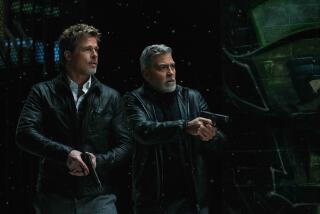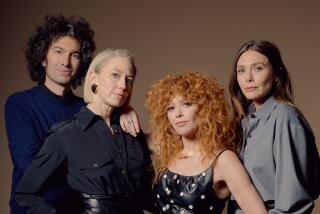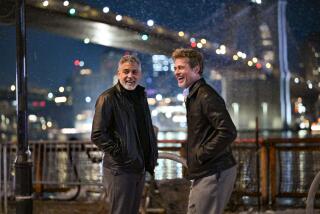Why George Clooney wanted his apocalyptic drama âThe Midnight Skyâ to end with a sense of hope
George Clooney has long been one of Hollywoodâs most globetrotting stars, but these days he is hunkered down with his wife, Amal, and their two young children in their home in Studio City, Calif. When Clooney bought this house in 1995, he was saving lives every Thursday night on NBC as Dr. Doug Ross on âER.â Now, with a deadly pandemic raging, all he can do is try to tend to those he cares about most.
He worries about his elderly parents, who live in Kentucky. He and his wife have regular dinners over FaceTime and Zoom with them as well as with friends, to keep in touch and stave off the sense of isolation. He is grateful that his 3-year-old twins, Alexander and Ella, are too young to understand whatâs going on.
âEverything for them is still playtime,â the 59-year-old actor-director said by phone on a recent afternoon. âIf thereâs any advantage to all this, itâs that I wake them up every morning and put them to bed overnight, my wife and I. I wouldnât have been doing that probably if we were on the road or working or something. So thereâs that at least.â
As it happens, when the pandemic hit in March, Clooney had just finished shooting his seventh and most ambitious directorial effort, postapocalyptic sci-fi film âThe Midnight Sky.â Set 30 years in the future, the film centers on a lonely man facing the end of the world and deals with themes of isolation and connection, hope and despair. Before 2020 came along, it all felt a little more like make-believe to Clooney. Reality is a whole different ballgame now.
In âThe Midnight Sky,â which is now streaming on Netflix and costars Felicity Jones and David Oyelowo, Clooney plays Augustine Lofthouse, an aging scientist with cancer, living alone in the Arctic in the wake of an unexplained global catastrophe that has rendered the planet uninhabitable. Joined by a silent young girl who mysteriously appears in his remote station, Lofthouse embarks on a desperate effort to communicate with the crew of a spacecraft that has been on a mission to Jupiter in order to warn them not to return to Earth.
Adapted by screenwriter Mark L. Smith (âThe Revenantâ) from Lily Brooks-Daltonâs 2016 debut novel, âGood Morning, Midnight,â the script for âThe Midnight Skyâ first came to Clooney as a potential acting gig. With a budget of $100 million and dual storylines set in space and in the frozen Arctic, the project was essentially two films in one â an Arctic survival thriller and a sci-fi adventure set in space â with a scope and scale beyond any of the previous films Clooney had directed, which include âConfessions of a Dangerous Mind,â âGood Night, and Good Luckâ and âThe Ides of March.â But, intrigued by the storyâs themes, he decided to take on the challenge.
Contemplating the end of the world was nothing new for Clooney. âI grew up in the â60s, doing duck-and-cover drills,â says the actor, who lost 25 pounds and grew a bushy beard to play the gaunt and grizzled scientist. âWe were always living under the idea that at some point weâre going to have a nuclear exchange with the Soviet Union. Then as time wore on and the Berlin Wall came down, it became about other things: Is it going to be India and Pakistan that blow us all up? Then climate change became a political hot potato. There have been so many different versions of ways we could blow it if we donât pay attention.â
In âThe Midnight Sky,â Clooney saw echoes of the 1959 film âOn the Beach,â based on Nevil Shuteâs postapocalyptic novel in which a submarine commander (Gregory Peck) cruises the seas in the aftermath of a nuclear war. But while that movie â a clip of which is shown in âMidnight Skyâ â ends with utter doom, Clooney wanted to leave audiences with at least some glimmer of optimism by highlighting humanityâs resilience and capacity for love.
âTo me, thereâs always hope as long as you can say, âWe can fix this, it doesnât have to end this way,ââ he says. âFor this story in particular, there is real hope at the end. Itâs not âOn the Beachâ: Kiss Gregory Peck goodbye and thatâs the end of it.â
âObviously we had no idea we would be in the midst of a global pandemic when the thing was coming out,â says Grant Heslov, Clooneyâs longtime producing partner. âBut at the end of the day, we both feel that the movie is semi-hopeful. Itâs this huge canvas: Weâre in space, weâre in the Arctic. But itâs really this story about connections and redemption.â
Shooting the Arctic scenes in Iceland last fall, Clooney didnât have to look far to get a sense of the existential peril posed by climate change. Arriving to shoot on a glacier, the âMidnight Skyâ team discovered that rain had melted all the snow, forcing them to move the production further out in search of a suitably icy landscape and adding an extra 45 minutes of travel each day to and from the set.
âThere is no argument about the science in a place like that because theyâre living it,â Clooney says. âTheyâre on the front lines. Theyâre the canary in the coal mine. When you get to Iceland, the first thing you take away is there isnât a single person that doesnât know exactly what global warming means to them. It would be a good lesson to all of us in terms of taking this seriously.â
Even as Clooney was getting a handle on the filmâs complex production challenges, circumstances forced him to pivot. While shooting in Iceland, just weeks before production was to begin on the space portion of the film, he received a call from Jones â who was set to play a member of the spacecraft crew who, we learn, is Augustineâs long-lost daughter. âFelicity said, âI have some interesting news: Iâm pregnant,ââ Clooney says. âFirst you say, âFantastic!â And then the reality sets in.â
Initially, Clooney set out to shoot around Jonesâ pregnancy, using a body double and digital effects to hide her growing bump. But after wrestling with it for about a week, he decided to embrace the situation and simply make her character pregnant. âMy pitch to Felicity was, âLetâs deal with this like Frances McDormand in âFargoâ: Sheâs pregnant and she still does all the things she has to do.â She was relieved.â
Making the character pregnant instantly brought a measure of hope to a story that could otherwise have felt irredeemably bleak. âIt adds so much complexity between the relationships and also just the meaning of the film,â says Heslov. âHereâs a father reaching out to save his daughter, who he has never been there for, and he gets the chance to save her and his grandchild.â
As the pandemic hit, leaving Clooney and his team to struggle through postproduction remotely, his sense of the movie he was making shifted yet again. While âMidnight Skyâ had originally centered largely on fears of the apocalypse, social distancing brought other elements increasingly to the fore.
âOnce we started editing, it became clearer and clearer that the bigger theme was how damaging it is to not be able to communicate and be near the people that you love,â Clooney says. âI didnât understand how deeply important the lack of communication was until I was living it. I think none of us did.â
For Brooks-Dalton, seeing how life during the pandemic has dovetailed with the themes of isolation and existential fear in her book has been a surreal but not entirely disheartening experience.
âWriting a book is such a solitary experience in and of itself,â she says. âTo look up from crafting these isolated characters and the world they find themselves in and realize that the rest of the world has joined me in this imagining â and that we are not in fact imagining but we are here together in the present tense â is wildly disconcerting. But there was an element of comfort in that for me. The alignment of our collective consciousness is very powerful, and if thereâs any silver lining here, which I think is hard to find, itâs that.â
Having shot the film in a 65-millimeter format intended for IMAX viewing, Clooney had hoped that a large number of viewers could take in this end-of-the-world story in their local multiplexes. But as we head into the most dangerous phase of the pandemic, Netflixâs planned big-screen rollout have been pared back to a handful of independent theaters and drive-ins. âThat [big-screen experience] was an exciting part of it,â Clooney says. âBut there are much bigger issues in the world than you donât get to show your movie in movie theaters. So you just kind of suck it up and take it.â
It remains to be seen whether moviegoers who have already been beaten down by months of relentlessly grim news are in the mood for Clooneyâs take on the end of the world. To some, âThe Midnight Sky,â which has earned mixed reviews from critics, may seem perfectly timed. To others, it may be exactly the wrong movie for this already dystopian and lonely moment.
As we head into a dark winter, with vaccines coming even as hospitals become overwhelmed, Clooney finds himself caught â much like the characters in âThe Midnight Skyâ â between the poles of hope and despair. âThere really is light at the end of this tunnel and thereâs a way out,â he says. âBut boy, thereâs going to be a lot of damage done before we get there.â
Taking the long view, though, he maintains hope that our species has a ways to go before the final bell marking midnight strikes.
âIâm a realist â I can look at the world and see exactly what it is. Every great love story ends in tragedy: You die,â Clooney says. âBut Iâm always optimistic that sooner or later weâre going to get these things right. Itâs going to take a lot of effort and weâre not going to see all of it in our lifetime. But thatâs part of our job, to keep rolling that ball up the hill.â
More to Read
Only good movies
Get the Indie Focus newsletter, Mark Olsen's weekly guide to the world of cinema.
You may occasionally receive promotional content from the Los Angeles Times.











